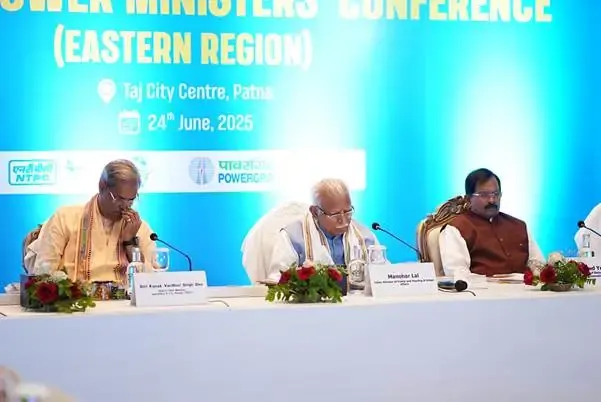How Will States Contribute to India’s Peak Electricity Demand Reaching 446 GW by 2034–35?

Synopsis
Key Takeaways
- Peak electricity demand to reach 446 GW by 2034-35.
- Importance of renewable energy and storage systems.
- Need for nuclear power projects in every state.
- Significant allocation in the Union Budget for transmission infrastructure.
- Cybersecurity measures are essential for grid resilience.
Patna, June 24 (NationPress) The peak electricity demand in India is anticipated to soar to 446 GW by the year 2034–35. To meet this demand sustainably, proactive planning and ongoing collaboration between the Centre, states, and various stakeholders are essential, as stated by Power Minister Manohar Lal during the Regional Conference for the Eastern Region States/UTs held in Bihar's capital.
The minister emphasized that states should actively promote renewable energy alongside energy storage systems to ensure reliable power supply.
India successfully managed a peak power demand of 250 GW in May 2024 and 242 GW so far in 2025.
“The peak demand is expected to increase further, nearing 270 GW later this year, showcasing India's transition from a power-deficit to a power-sufficient nation,” the minister remarked.
He stressed the significance of continuous cooperation between the Central and state governments to realize the vision of Viksit Bharat by 2047.
Manohar Lal highlighted the evolution of India’s power system into a unified national grid, fulfilling the goal of ‘One Nation-One Grid’, and underscored the necessity for a modern, financially viable power sector to support the nation's growth.
He pointed out the need for ensuring resource adequacy and establishing essential power generation capacity tie-ups.
“In developing their resource adequacy plans, states must also ensure a balanced and diversified power generation mix. This includes the addition of nuclear generation capacity, aiming to establish at least one nuclear power project in each state,” the Power Minister advised.
He urged states to address challenges related to intra-state transmission projects, including issues related to Right of Way (RoW).
States should explore various financing options, including listing transmission utilities and seeking funding from multilateral institutions.
The minister announced that the Union Budget 2025-26 has allocated Rs 1.5 lakh crore in 50-year interest-free loans to assist states with their capital expenditures, thereby strengthening transmission infrastructure.
He noted that India is progressing towards a higher share of renewable energy, which has risen from 32 percent in 2014 to 49 percent in April 2025, reflecting the national ambition to attain 100 GW of nuclear energy by 2047.
The Union Minister also highlighted the significance of cybersecurity in the power sector and discussed 'Islanding Schemes' as effective strategies to mitigate power outages due to cyber incidents and enhance grid resilience.









